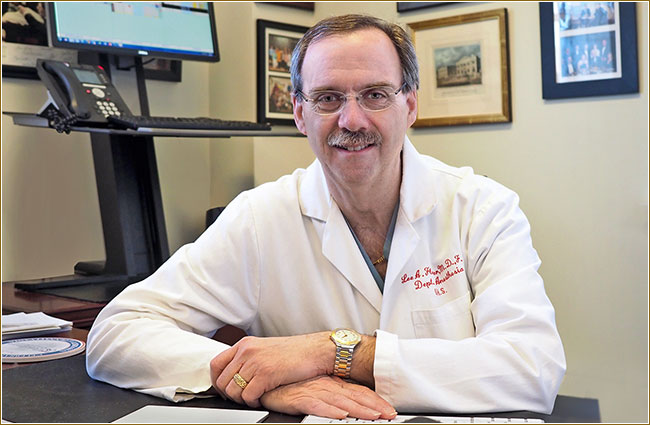News
Inside the National Academies’ Abortion Safety Study Committee
Penn Medicine's Lee Fleisher Discusses His Time on the 13-Member Panel of Investigators

Perelman School of Medicine Professor and LDI Senior Fellow Lee Fleisher, MD, was on the committee that produced the National Academies of Sciences, Engineering and Medicine’s newly released report on the safety and quality of abortion care in the U.S.
Looking back over the 14 months he served on the committee that produced the new National Academy of Sciences, Engineering and Medicine report on the Safety and Quality of Abortion Care in the United States, University of Pennsylvania Professor Lee Fleisher said the work found abortions to be safe and that some state laws and regulations can interfere with that.
“There is a great deal of data demonstrating that abortion performed in the United States is safe and should be performed using safeguards similar to other minimally invasive procedures,” said Fleisher, MD, who chairs the Perelman School of Medicine Department of Anesthesiology and Critical Care and is a Senior Fellow at Penn’s Leonard Davis Institute of Health Economics (LDI).
One of the conclusions of the 200-page report is that “Abortion-specific regulations in many states create barriers to safe and effective care.”
Fleisher was one of 13 top national health care authorities selected to conduct what is known as a “Consensus Study Report” of the issue. The last such study on abortion care was done in 1975, just two years after the landmark Roe v. Wade U.S. Supreme Court decision struck down state laws that banned the procedure. In the intervening 42 years, researchers around the world have created a broad body of new abortion care-related evidence and insights.
Latest evidence
Consensus studies by the National Academies — the country’s highest scientific authority on medical issues — are frequently performed to create reports synthesizing the latest evidence-based findings in any given field of academic research. In this case, the 13-member committee analyzed four decades of “well-designed randomized control trials, systematic reviews, and epidemiological studies that have examined the relative safety of abortion methods and the appropriateness of methods for different clinical circumstances.”
A physician-scientist, Fleisher’s past research has focused on ambulatory care risk and anesthesia care.
Facilities
More than 95% of U.S. abortions take place in non-hospital facilities and those clinics and office-based facilities are regulated by the individual states.
“Over the course of the study,” Fleisher said, “I learned about some state laws that require providers to inform women about the long-term risks of abortion. What surprised me is how much the selective recall bias and selection bias makes it so difficult to do research on this question and how many of the claims of long-term harm related to abortion were not supported when only high quality studies were reviewed.”
“Overall,” said Fleisher, “the committee question was, given the low risk to the women for abortion services, what should the standard of care be because you have anything from what happened in the Gosnell case to the state of Texas saying that the facilities’ had to be at the standard of a hospital operating room and that physicians had to have hospital admitting privileges.”
We asked what are the right safeguards as a minimum standard? And for what current standards is there no evidence base and how does that compare to other similarly low-risk procedures?
Lee Fleisher, MD
“We asked what are the right safeguards as a minimum standard?,” Fleisher continued. “And for what current standards is there no evidence base and how does that compare to other office or ambulatory-based procedures?”
‘Very careful work’
“This was very careful work,” said Fleisher, “It started with the premise that abortion is currently legal and asked if we’re sure we have the right training for the practitioners — ranging from OBGYNs, nurse practitioners, family medicine providers, anesthesiologists and others, to make sure it’s safe. We were also asking what are the right facilities in which to delivery abortion care?”
“I spent much of my committee time researching facility standards and how they fit into the rest of the ambulatory surgery world,” Fleisher said.
“There is a great deal of cohort data that medication abortion is very safe and surgical or procedural abortion is similarly safe when practiced using current standards for other similar procedures such as appropriate personnel and monitors,” said Fleisher.
Barriers to access
“Barriers to access was a question because we know that the longer you delay for abortion, the higher the risk to the woman,” Fleisher said. “In another area, we found that 17% of the women had to travel 50 miles or more to get access.”
Fleisher pointed out that the analytical framework used by the committee was that established in the landmark 2001 IOM Crossing the Quality Chasm, that defined six domains of quality by which health care services should be measured: safety, effectiveness, patient-centeredness, timeliness, efficiency, and equity.
The 14-month project, which began distributing its 200-page final report last Friday, was funded by six outside philanthropic foundations: David and Lucile Packard Foundation, Grove Foundation, JPB Foundation, Susan Thompson Buffett Foundation, Tara Health Foundation, and William and Flora Hewlett Foundation.
